高山菇: High as a High Mountain Mushroom
Log-grown shiitake, space bag lion's mane, and a Taiwanese community cookbook
This is Yun Hai Taiwan Stories, a newsletter about Taiwanese food culture by Lisa Cheng Smith 鄭衍莉, founder of Yun Hai Taiwanese Pantry. If you aren’t yet a subscriber, sign up here.
Today, we launch organic high mountain mushrooms, sourced from growers that still use logs in their commercial cultivation of shiitakes (aka xiang gu 香菇). This practice is as close as farmers can get to producing wild mushrooms, but also speaks to human connections to the forest and what it means to develop an understory economy. It’s a mistake to think of agriculture as taking place only on farmlands, separate of woodlands and other biomes. In this case, the forest and the farm are intimately connected. Read on.
Three parts yang to seven parts yin. Three parts light to seven parts dark. Three parts clarity to seven parts mystery.
This is Wu Ru-Ying’s 吳如瀅 formula for growing organic shiitake mushrooms in the high mountains of Yunlin in Central Taiwan, where she and her husband Chen An-Chiang 陳安獎 are some of the last mushroom growers in the region to cultivate them the traditional way: on cut logs inoculated with shiitake spawn.
The humble shiitake (the oak-tree mushroom, the gift of farmer god Shen Nong 神農, the fungi of vitality) is an everyday food that imparts an unmistakeable savory flavor, especially when dried. It’s essential to dishes like Lu Rou Fan, Taiwanese Oil Rice, and Braised Cabbage.
Shiitake are the humblest of things—every halfway respectable Taiwanese pantry has dried shiitake in it—but their origins are enshrined in mystery and reverence. They are ancient organisms that have been growing wild and free in the forests of this earth for almost a hundred million years, since the Cretaceous period. I hate to even say this because I have two small children and am completely dinosaur-jaded, but, yes, dinosaurs probably ate them.
Though humankind has likely eaten mushrooms since the very early days of our coming into being—everything we know about edible mushrooms comes from the adventures of those who came before—we’ve been cultivating shiitake for a relatively short time: about 1000 years, give or take. During the Song Dynasty, Wu San Kwung found that slashing logs on the forest floor and giving them a good whack would stimulate shiitake mushroom growth. So that’s what he did, and the first log-grown shiitake operation was born. For this, he was memorialized in temples and statues throughout China. Such is the importance of this little brown mushroom.
For the vast majority of the past thousand or so years, shiitake were cultivated on logs, à la Master Kwung. Eventually the wood-whacking evolved to include the inoculation step: make holes in freshly cut logs, insert mushroom spawn, and wait for the mycelium to grow throughout. After enough time passes for the organism to develop, and when the conditions are right, the shiitakes fruit. The whole thing takes about one year from log to ‘shroom. Sometimes less, sometimes more.
This practice, like so many old, slow things, has started to disappear in commercial production.
Many farms now use space bags 太空包—plastic bags filled with compressed sawdust or other woody mediums. You may be familiar with a version of these as grow-your-own kits. The general concept is to create an artificial log that can support mycelium and their fruiting bodies.
These are less expensive to farm, faster to turnaround, and can easily be set up indoors within a controlled, organic environment. This is a good thing. Space bag mushrooms are an ingenious way to make use of spent materials to create a food source. We love what our friends at Smallhold are doing, for example, transforming urban indoor spaces into organic mushroom farms.
But the old way of log growing remains relevant and deserves our attention. For one thing, growing mushrooms on wood requires relatively scant resources to get a healthy crop, if you’re willing to wait. I recently passed a log micro-farm at Randall’s Island Park in New York City; a stack of salvaged logs in a space the size of two park benches, fruiting busily. People can grow mushrooms almost anywhere there is a bit of shade, light, and moisture. I would encourage looking into this if you’re anywhere near woodland: Forest and Field Products is a great resource.
Log growing is also sublimely poetic, "turning something that’s dying into fruit," as my friend, neighbor, and mushroom grower Kelli Cain (who runs Luck Dragon with her partner Brian) described to me. This speaks to the natural cycle of life and decay,and our place in it—“kindly use” is part of being here on this earth (cc: Wendell Berry). Trees need to be pruned for health (a split-trunk maple is prone to breakage), and new growth forests should to be thinned to bring in light, encourage air circulation, and prevent fires.
Mushrooms can grow on forest offcuts, feeding us before the logs turn into humus. It’s a beautiful cycle. This kind of production is sometimes called the understory economy in Taiwanese forestry, where understory refers to the layer of vegetation and animal life below the canopy. It’s a beneficial arrangement that, when done properly, is good for both the forest and humankind. With the right knowledge, we can live well within natural environments without ruining them. That said, not all log-grown operations are gentle; the wanton clearing of forest land is not the idea here. Stay vigilant.
Log-grown mushrooms can only be grown outside, where they are exposed to the sun and the moon, the light and the shade, the wind and the rain, the hot and the cold. The mycelium on logs also have access to a different set of nutrients, including lignin, the compound responsible for making trees woody (and completely indigestible by us). The mushrooms make the nutrients of the tree available to us, in a soft and velvety form.
In conclusion: I love a good space bag ‘shroom but for a truly exquisite mushroom that is a-thing-of-the-trees, I recommend going whole hog on the log.
Which brings us to the main subject.
Ying Ying Grange 盈盈農圃
We source our mushrooms from Ying Ying Grange, 1300 meters above sea level. Wu and Chen run the farm together; it’s been in Chen’s family for three generations. In a region known for log-growing mushrooms, they are one of the last to continue the practice, which came to popularity during the Japanese colonial period. Wu said that her father-in-law considered giving it up, but persisted because “good things must go on.”
The farm’s continued existence is in large part due to Wu, who moved to the farm from her native Tainan after she married. She had become disillusioned with her office job and was interested in friendly agriculture and organic practices. It was difficult for her to get buy-in from her community because she was a new farmer and organic practices meant more labor and lower yields.

Though she and her husband began with a focus on tea farming, they eventually turned their attention to mushrooms, observing that methods used by Chen’s family were already very natural. The logs themselves are organic to begin with. Over time, they built up the mushroom farm and certified it as organic in Taiwan. No pesticides are used; they literally pick the slugs off by hand (at least the ones that the snakes don’t eat).
Wu describes her journey: “Although there were ups and downs along the way, they became clouds and fog, and after they dispersed, I returned to my original intention of living in the mountains and forests.” What a beautiful way to think about hardship: clouds that will disperse.
Yinh YIng Grange produces both log-grown shiitake and space bag lion’s mane on their farm. Both are collected by hand the instant they are ready (not too small, not too big, not too soft, not too tough), often in the late hours of the night or early morning. They are then left out to dry in the sun, which increases the vitamin D content of the mushrooms because they create this nutrient from sunlight.
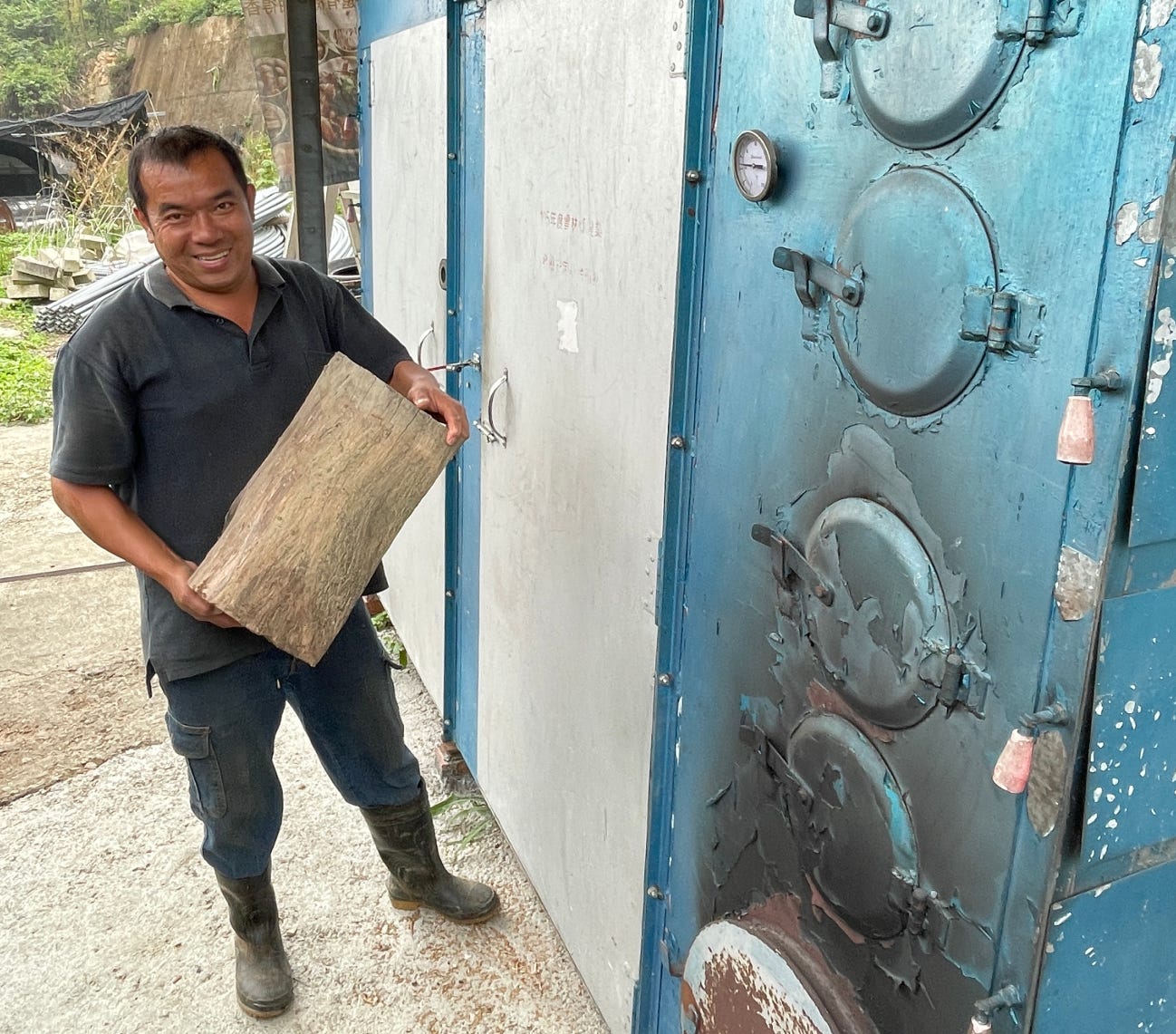
Next, the mushrooms are smoke-dried over a low-temperature longan wood fire, fueled by lumber from the pruning of fruit orchards. This smoke imbues the mushrooms with the lightest touch of smoke, an almost coffee-like aroma. The layers of mushrooms must be rotated in the smoker for even exposure; and the low, slow fire is watched for 48 hours by Wu and Chen to make sure the flame persists. Because the fire is so delicate, they sleep next to the smoker, taking turns stoking it.
Finally, the mushrooms are packed and sent to restaurants and retailers, or sold directly to customers at farmer’s markets. We’ve put them into reusable silkscreened canvas bags, as they’re best shipped and stored in a dry, dark place.
Dried Organic Shiitake
To produce their log-grown shiitake, new logs are procured from tree-growers engaged in reforestation initiatives incentivized by the Forestry and Nature Conservation Agency, Ministry of Agriculture. Small and medium sized trees are sometimes logged from these forests to encourage stronger growth of larger trees, and they provide interim income to those engaged in reforestation. According to National Taiwan University, this type of understory economy can help promote sustainable development of mountain villages.
Though shiitake mushrooms are known to appear on oak logs, they also grow on many types of hardwood trees. They take quite well to the native Formosan Sweet Gum tree, Liquidambar formosana, which is part of the list of approved forestation species. This is what Ying Ying Grange uses.
Note for the observant: on our packaging the mushrooms are described as being grown on basswood logs. They are not grown on basswood logs; that was an initial mistranslation of cut logs 段木 that we did not initially catch. This will be amended in future runs.
Holes are drilled at regular intervals throughout the logs, and sawdust plugs with shiitake spawn are inserted into the holes and sealed with wax. The mycelium—the rootlike structure of a fungus—starts to grow slowly inside the log, working its way throughout. During this time, the logs need to be wetted and moved about (whacked) to encourage full development of the root network.
Log growing is log moving. Because the integrity of the bark must be preserved for the mushroom to fruit well, the logs are handled gently by hand. Every 45 days or so, the Ying Ying Grange team takes each log, flips it over, soaks it in mountain spring water, and then restacks it. This is the bulk of the labor; in one season, the farmers may move over 100 tons of wood. Do this 1000 times fast:
After 10 months, the log will finally begin to fruit. It will do so several more times, with periods of rest between, until the nutrition in the log is fully spent.
In the end, the decayed logs are a perfect nest for native beetles. The wood is chopped and provided to insect shops or stacked in the Ying Ying tea garden to encourage their presence. After the beetles are done, the logs breaks down into humus which is used as a natural fertilizer in the Ying Ying Grange tea garden or given away to members of their community.
Dried Organic Lion’s Mane
Lion’s Mane Mushroom or Hericium erinaceus is a beautiful and well-loved mushroom that has long spines, a fluffy appearance, and a texture reminiscent of crab meat. In Chinese, it’s known as Monkey’s Head Mushroom 猴頭菇. Like the shiitake, Lion’s Mane are grown organically at Ying Ying Grange, kept pest-free by hand, and smoke-dried over wood fire.
Lion’s Mane has been used in Traditional Chinese medicine for a long time, with reported benefits including whole-body nourishment, neurological health, and good digestion. Popular among vegans and vegetarians in Taiwan, they are known to be rich in protein, minerals, amino acids, and vitamin D (the only non-fortified, non-animal source of that vitamin other than the sun itself). Preparations include red-braised lion’s mane, three-cup lion’s mane, deep fried lion’s mane, sesame oil lion’s mane soup, and even cumin lion’s mane skewers. The flavor is mild, mineral, and evocative of the sweetness of seafood. It looks delicate, but it really holds up; I’d recommend ripping it into smaller pieces before cooking.

It looks intimidating, but it’s relatively easy to prepare: soak a handful of mushrooms in water for five minutes, wring them out, and repeat a couple of times. If you’re putting them into a soup, you probably only need to do this once. Once soaked, the mushroom becomes soft and pliant; tear it into pieces and proceed with your recipe.
We’ve already featured these in a simple soup recipe starring our Aged Daikon, but we’re soon releasing a take on the classic Sesame Oil Chicken Soup, using Lion’s Mane mushroom instead. Look for it on Instagram in the coming days.
Taiwanese Homestyle Cooking, a Community Cookbook
Just in time to aid your mushroom cooking adventures, we’ve expanded our Taiwanese cookbook collection online, adding new publications like the latest masterpiece from Bao London and Cathy Erway’s instant classic The Food of Taiwan.
We’ve also included a self-published book that isn’t available at most bookstores and doesn’t even have an ISBN number: the bilingual cult classic Taiwanese Homestyle Cooking, a book compiled and published by the North America Taiwanese Women’s Association and the Taiwanese American Citizens League. The book was first published in 1995 to benefit a Taiwanese youth summer camp, and was only reprinted once. I had an ebay alert going for years on this one, and was overjoyed when the TACL organization reissued it in 2022.
Produced by Taiwanese American Citizens League – Leading Youth Forward (TACL-LYF), the book is a beautiful bilingual compilation of recipes written, tested, and passed down by our Taiwanese parents and grandparents in collaboration with 2nd generation Taiwanese Americans. It includes suggested menus for various occasions and quick guidelines for prep time, complexity level, and significance in Taiwanese culture.
All proceeds benefit the youth summer camp they still run in the Bay Area. Which, by the way, could probably use a breakout session on whether or not dinosaurs ate shiitakes, and if so, were they log-grown or not.
Three parts Dwarf Fortress to seven parts Stardew Valley,
Lisa Cheng Smith 鄭衍莉
Research and editorial assistance from Amalissa Uytingco, Jasmine Huang, Luke Miller, and Lillian Lin. Many thanks to Kelli Cain for the log-growing tips. If you enjoyed this newsletter, please share it with friends and subscribe if you haven’t already. I email once a month, sometimes more, sometimes less. For more Taiwanese food, head to yunhai.shop, follow us on instagram and twitter, or view the newsletter archives.




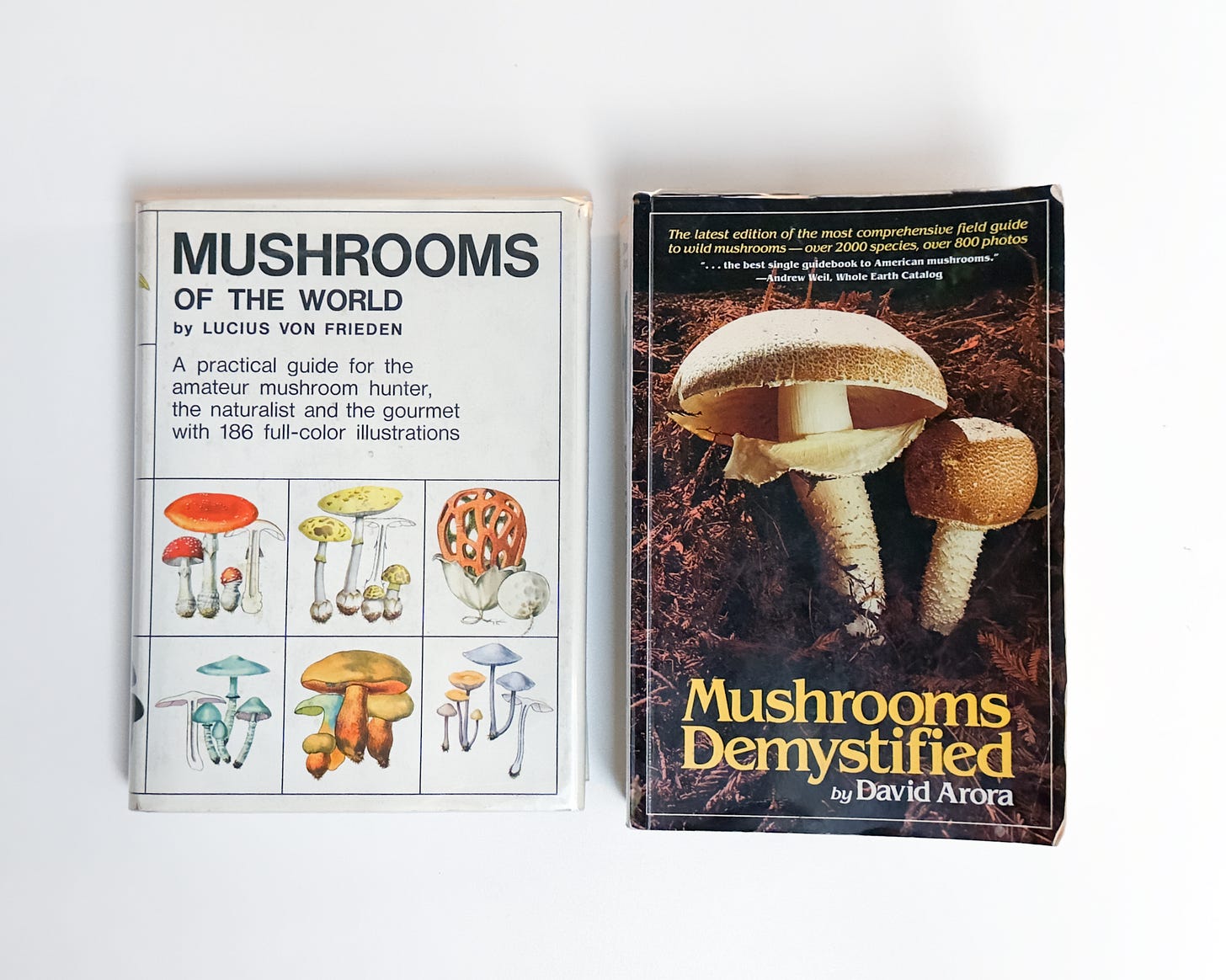



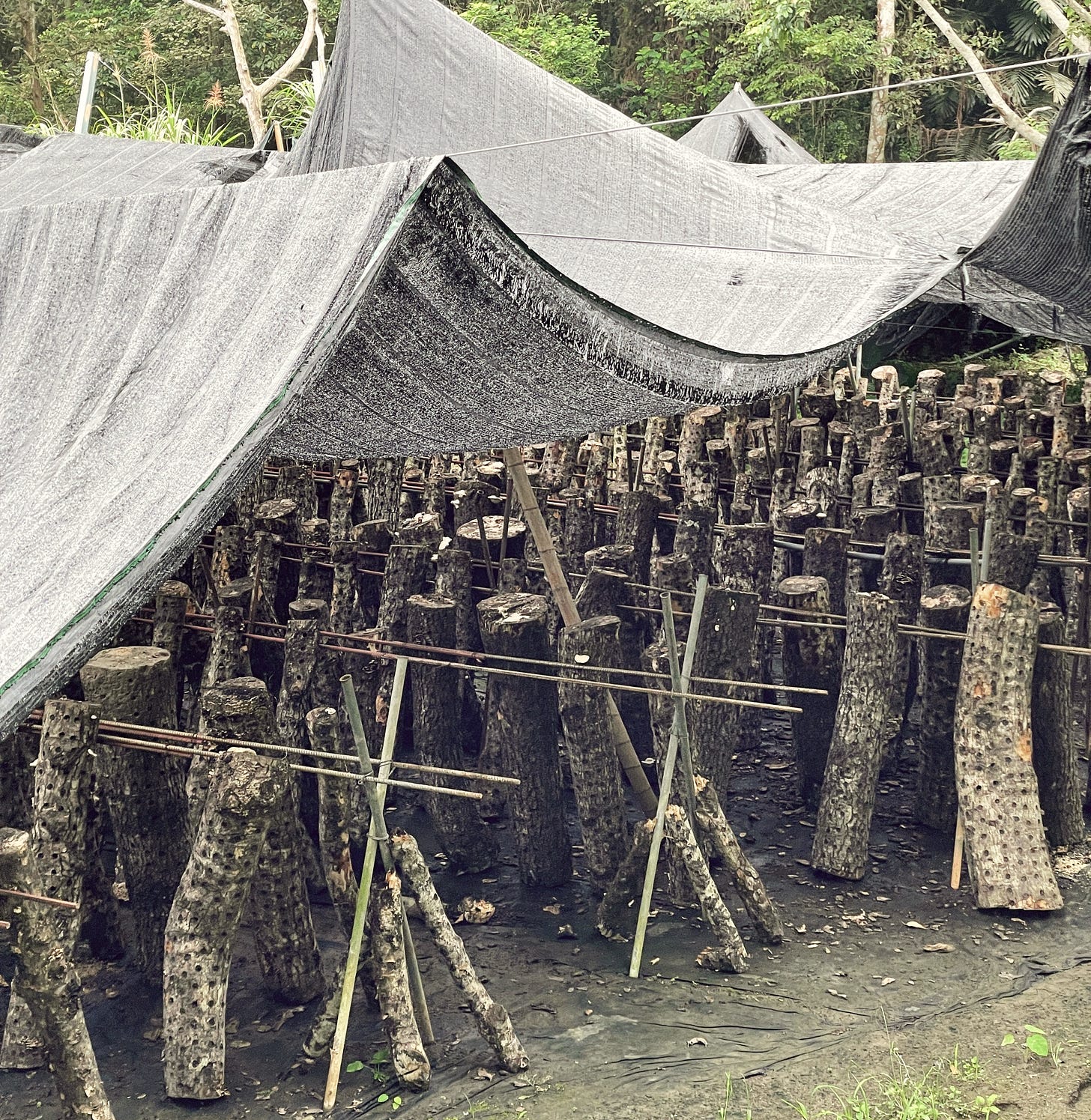
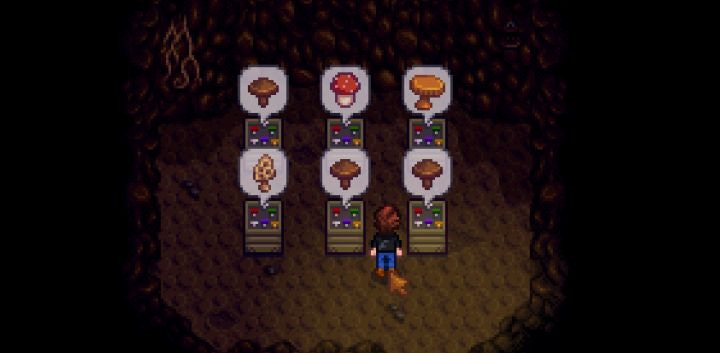






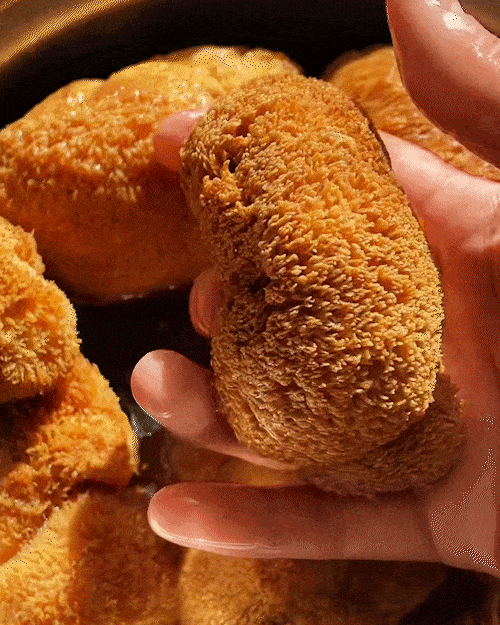
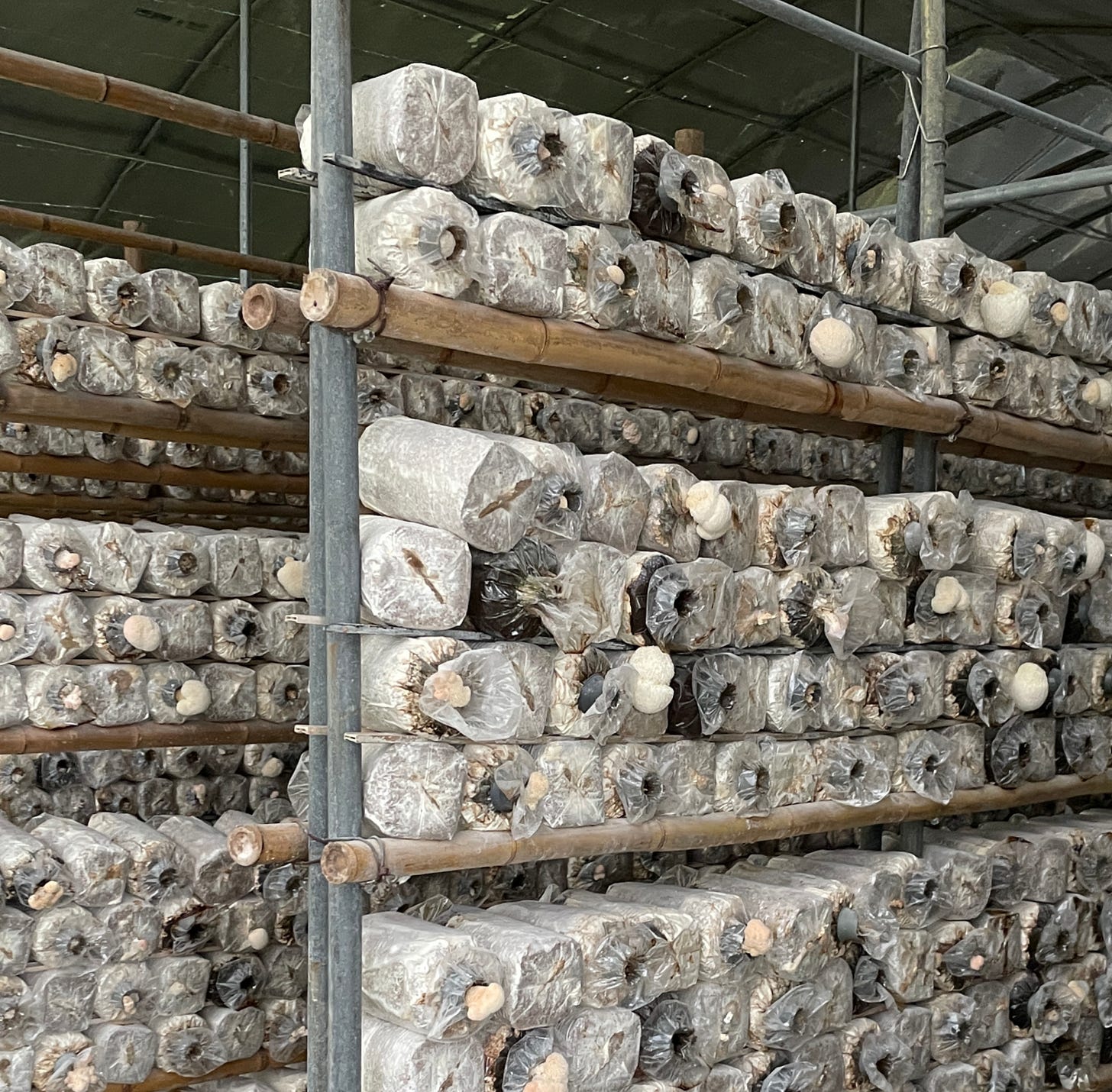


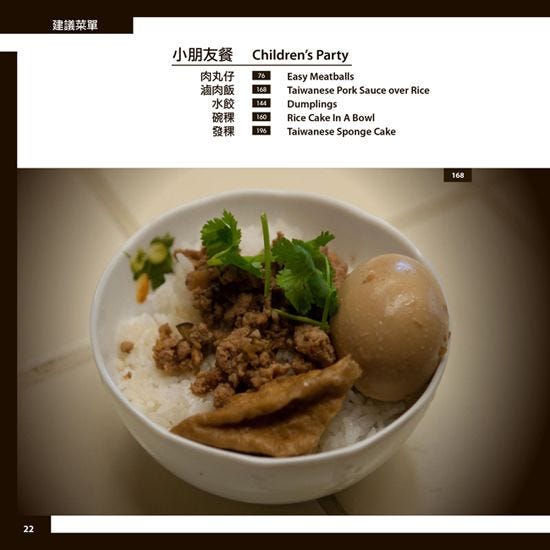
Loved reading this piece and love this newsletter 🥹